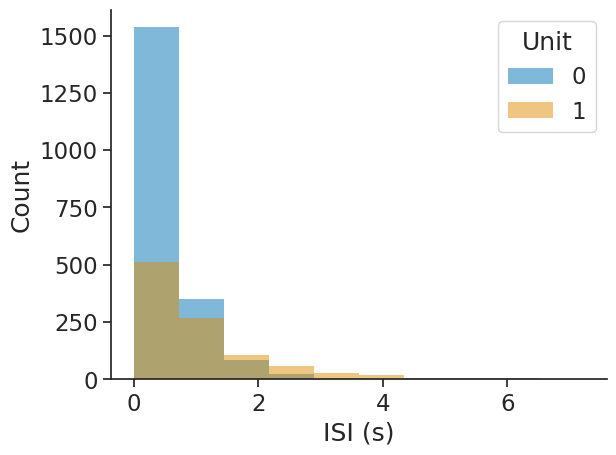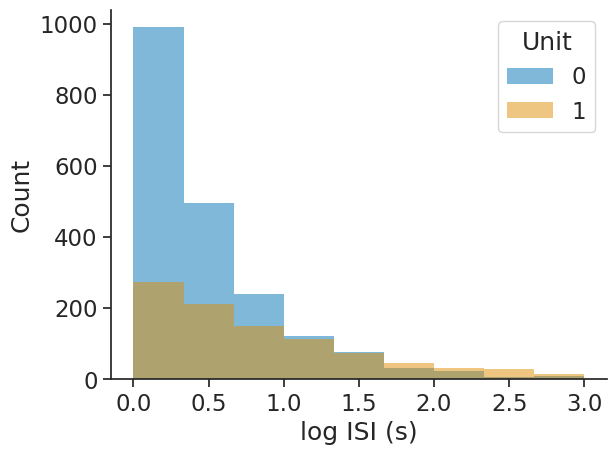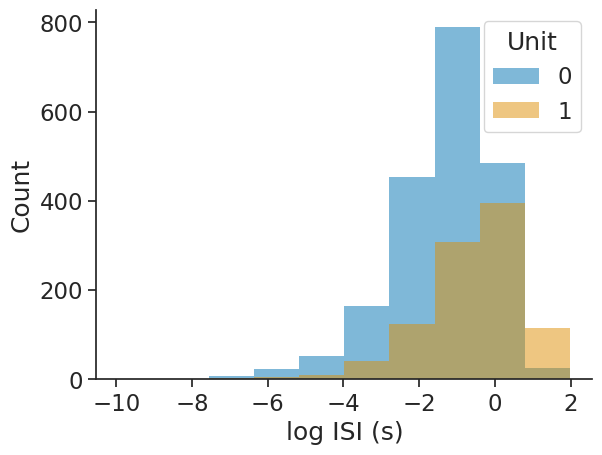Correlograms & ISI#
Let’s generate some data. Here we have two neurons recorded together. We can group them in a TsGroup.
ts1 = nap.Ts(t=np.sort(np.random.uniform(0, 1000, 2000)), time_units="s")
ts2 = nap.Ts(t=np.sort(np.random.uniform(0, 1000, 1000)), time_units="s")
epoch = nap.IntervalSet(start=0, end=1000, time_units="s")
ts_group = nap.TsGroup({0: ts1, 1: ts2}, time_support=epoch)
print(ts_group)
Index rate
------- ------
0 2
1 1
Autocorrelograms#
We can compute their autocorrelograms meaning the number of spikes of a neuron observed in a time windows centered around its own spikes.
For this we can use the function compute_autocorrelogram.
We need to specifiy the binsize and windowsize to bin the spike train.
autocorrs = nap.compute_autocorrelogram(
group=ts_group, binsize=100, windowsize=1000, time_units="ms", ep=epoch # ms
)
print(autocorrs)
0 1
-0.9 0.9875 1.14
-0.8 0.9750 1.10
-0.7 1.0525 0.97
-0.6 1.1150 0.98
-0.5 0.9575 1.05
-0.4 1.0150 1.10
-0.3 0.9850 0.95
-0.2 1.0500 0.84
-0.1 1.0350 1.07
0.0 0.0000 0.00
0.1 1.0350 1.07
0.2 1.0500 0.84
0.3 0.9850 0.95
0.4 1.0150 1.10
0.5 0.9575 1.05
0.6 1.1150 0.98
0.7 1.0525 0.97
0.8 0.9750 1.10
0.9 0.9875 1.14
The variable autocorrs is a pandas DataFrame with the center of the bins
for the index and each column is an autocorrelogram of one unit in the TsGroup.
Cross-correlograms#
Cross-correlograms are computed between pairs of neurons.
crosscorrs = nap.compute_crosscorrelogram(
group=ts_group, binsize=100, windowsize=1000, time_units="ms" # ms
)
print(crosscorrs)
0
1
-0.9 0.885
-0.8 0.930
-0.7 1.045
-0.6 0.895
-0.5 1.020
-0.4 1.045
-0.3 1.020
-0.2 0.970
-0.1 0.995
0.0 0.950
0.1 0.990
0.2 0.885
0.3 1.030
0.4 0.920
0.5 1.060
0.6 0.925
0.7 1.110
0.8 1.040
0.9 0.865
Column name (0, 1) is read as cross-correlogram of neuron 0 and 1 with neuron 0 being the reference time.
Event-correlograms#
Event-correlograms count the number of event in the TsGroup based on an event timestamps object.
eventcorrs = nap.compute_eventcorrelogram(
group=ts_group, event = nap.Ts(t=[0, 10, 20]), binsize=0.1, windowsize=1
)
print(eventcorrs)
0 1
-0.9 0.000000 0.000000
-0.8 0.000000 0.000000
-0.7 0.000000 2.777778
-0.6 0.000000 0.000000
-0.5 0.000000 2.777778
-0.4 0.000000 0.000000
-0.3 0.000000 2.777778
-0.2 0.000000 0.000000
-0.1 0.000000 0.000000
0.0 1.282051 0.000000
0.1 0.000000 2.777778
0.2 2.564103 0.000000
0.3 0.000000 2.777778
0.4 2.564103 2.777778
0.5 1.282051 0.000000
0.6 2.564103 2.777778
0.7 0.000000 0.000000
0.8 0.000000 0.000000
0.9 0.000000 0.000000
Interspike interval (ISI) distribution#
The interspike interval distribution shows how the time differences between subsequent spikes (events) are distributed.
The input can be any object with timestamps. Passing epochs restricts the computation to the given epochs.
The output will be a dataframe with the bin centres as index and containing the corresponding ISI counts per unit.
isi_distribution = nap.compute_isi_distribution(
data=ts_group, bins=10, epochs=epoch
)
print(isi_distribution)
0 1
0.361842 1536 511
1.085429 349 266
1.809016 86 107
2.532603 23 56
3.256189 2 28
3.979776 3 17
4.703363 0 5
5.426950 0 4
6.150537 0 4
6.874123 0 1

The bins argument allows for choosing either the number of bins as an integer or the bin edges as an array directly:
isi_distribution = nap.compute_isi_distribution(
data=ts_group, bins=np.linspace(0, 3, 10), epochs=epoch
)
print(isi_distribution)
0 1
0.166667 990 274
0.500000 497 213
0.833333 239 149
1.166667 123 114
1.500000 77 73
1.833333 31 46
2.166667 22 32
2.500000 5 29
2.833333 10 15

The log_scale argument allows for applying the log-transform to the ISIs:
isi_distribution = nap.compute_isi_distribution(
data=ts_group, bins=10, log_scale=True, epochs=epoch
)
print(isi_distribution)
0 1
-9.334036 1 1
-8.143184 0 1
-6.952332 7 2
-5.761480 22 5
-4.570628 51 9
-3.379777 164 41
-2.188925 454 124
-0.998073 789 308
0.192779 485 394
1.383631 26 114

